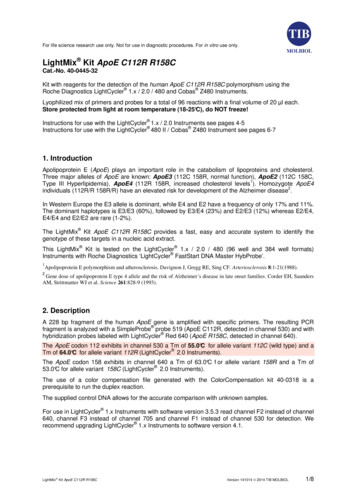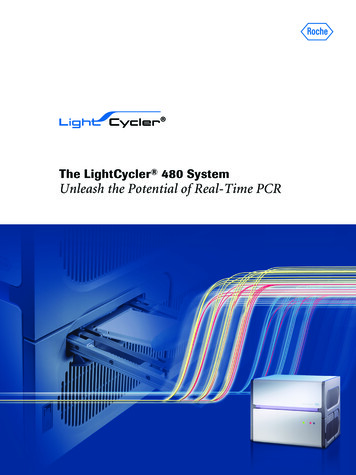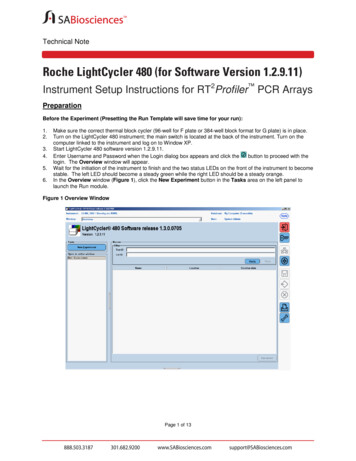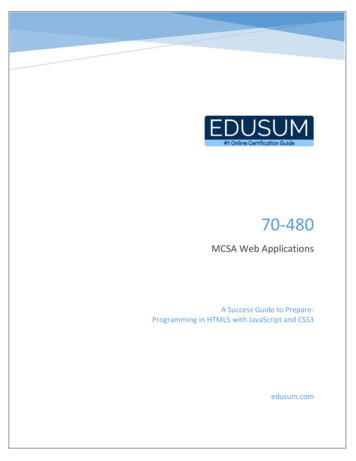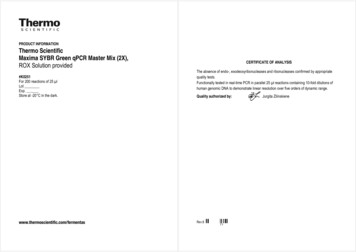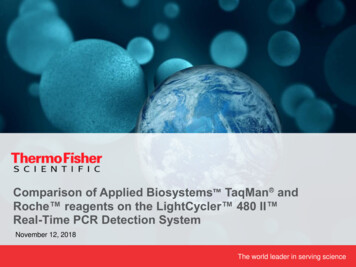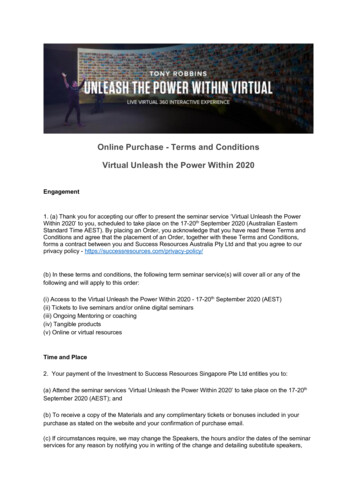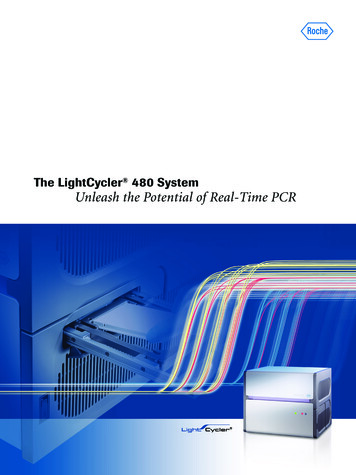
Transcription
The LightCycler 480 SystemUnleash the Potential of Real-Time PCR
Amplify your success in medium- and high-throughput real-time PCR applicationswith the innovative LightCycler 480 System, from Roche Applied Science.The plate-based LightCycler 480 System is a highly adaptable and versatilereal-time PCR system for the analysis of gene expression and genetic variation.The modern instrument design, outstanding technical and software features, as wellas advanced reagents and disposables of the LightCycler 480 System, exceed thedemands for fast, accurate, and most challenging real-time PCR applications.2The LightCycler 480 Real-Time PCR System3Introduction4Instrument Description5Software7Reagents and Disposables11Performance Data14Automatic Workflow Capabilities16System Service17System Characteristics18Ordering Information19
The LightCycler 480 Real-Time PCR SystemA standard for high-performance real-time PCRTake your real-time PCR projects to new levels of sensitivity, specificity, andthroughput with the accuracy, versatility, and speed of the LightCycler 480 System.Compelling reasons for choosing the LightCycler 480 System Unique silver thermal block cyclertechnology for exceptional well-to-welldata homogeneity. Advanced high-performance optical systemfor accurate data capturing. Easily interchangeable 96- and 384-wellthermal block cycler units. Optional clear or white plates, dependingon your workflow and sensitivity needs. Excellent PCR sensitivity with high-valueLightCycler 480 reagents and disposables. Highest flexibility with fluorescence dyes anddetection formats. Options for basic and advanced geneexpression analysis. Intuitive, user-friendly LightCycler 480software interface. Fast and easy assay setup with the newsample editor. One-click experiment setup with options torefine results later. Multi-function database with research andtraceable modes. Multiple plate analysis tools for extendedgenetic variation and gene expressionstudies. State-of-the-art LIMS connectibility. 21 CFR part 11 compliance data protection. Premium customer support and instrumentservice. Genetic variation studies based onHybProbe/SimpleProbe probes, highresolution melting or endpoint genotyping.Meet and exceed the capabilities ofother real-time PCR systems –take your genomic research to a new levelwith the LightCycler 480 System.3
The LightCycler 480 Real-Time PCR SystemProven, high performance LightCycler TechnologySince their introduction in 1998, the LightCycler Real-Time PCR Systemsfrom Roche Applied Science have stood for maximum flexibility, high speed,and outstanding data accuracy. In 2005, this tradition of continuous innovationwas brought to a new level with the LightCycler 480 high-throughput platebased platform.Innovative technological enhancements in theLightCycler 480 Instrument pave the way for newstandards of rapid and accurate real-time PCRdata generation and analysis. In particular, thesophisticated design of the silver thermal blockcycler unit, optical system, and software deliverthe sensitivity, accuracy, and reproducibility one hascome to expect from Roche Applied Scienceinstruments.IntroductionFor maximum flexibility, many components of theLightCycler 480 Instrument are modular in design.This setup enables users to easily interchangethermal block cyclers (96- and 384-well format),combine various optical filters, and choose betweenclear or white multiwell plates.Enhanced software capabilities allow seamlessintegration of the system into computer-controlledenvironments and automated workflows. Thissystem setup facilitates data management thatcomplies with 21 CFR Part 11 requirements.The LightCycler 480 System comprises versatileinstrumentation and software as well as highperformance reagents, customized qPCR assays(Universal ProbeLibrary System) and speciallyengineered disposable products. This innovativesystem meets the tough demands of qualitativetarget detection, quantitative gene expression, andmutation analysis. In addition, its built-in versatilityfacilitates easy adaptation to new technologies ingenomic research.Silver multiwell plate mountCircuit board(Peltier elements)Therma-Base layerCooling element Figure 1: Flexibility of the LightCycler 480 blockcycler unit. The LightCycler 480 block cycler units (96-well/384-well format) are easily interchangeable by the user, takingno longer than a few minutes. The exchanged block cycler unitis automatically detected and identified by the system, andexperiments can be pursued without time-consumingrecalibration runs.4 Figure 2: Schematic of the LightCycler 480 thermalblock cycler. The Therma-Base layer, implemented in the blockcycler unit architecture, is a thin cavity lined with a wickstructure and filled with fluid. Utilizing a series of condensationand evaporation events, the Therma-Base rapidly adjusts totemperature changes by efficiently dissipating heat.
The LightCycler 480 InstrumentAn ideal combination of speed, accuracy and versatilityInnovative PCR thermal block cycler designThe LightCycler 480 System has revolutionizedblock cycler temperature control through theintroduction of a highly efficient heat-equalizingtechnology (Therma-Base) between the heat blockand the cooling element. By removing the effects ofspreading resistance, the LightCycler 480 thermalblock cycler provides unparalleled well-to-welltemperature homogeneity, as illustrated by minimalinter-well temperature variability across the entiremultiwell plate. This innovative temperature controlenables exceptional data uniformity, independent ofany assay formats or real-time PCR applications,even in fast PCR protocols.Key benefits of the LightCycler 480 thermalblock cycler: Run any assay format or application with fastPCR protocols ( 40 minutes for 40 cycles in384-well plate format). Obtain rapid and accurate temperatureadjustment. Achieve exceptional data homogeneity acrossthe entire multiwell -19AFK21 PFigure 3: Temperature homogeneity across a 384well plate: a) LightCycler 480 Instrument; b) anotherreal-time PCR instrument. The melting temperature (Tm) ofa given labeled oligonucleotide was used to demonstrate13A17FK21 PRowsColumnsb temperature homogeneity across a multiwell plate (at 50 C).The variation between the measured Tm, and the expected Tmof the oligonucleotide was plotted for all 384 wells using theexpected Tm as zero.CPa 3Scale: 0.5CPScale: ure 4: Crossing point (CP) homogeneity across a96-well plate: a) LightCycler 480 Instrument; (b) anotherreal-time PCR instrument. A low target concentration (100copies) of a given target sequence (442 bp) was amplified usingb357Columns911ACEGRowsa fast PCR protocol (20 µl reaction volume, hydrolysis probeformat). CP values were plotted for all 96 wells using a 0.5-stepCP scale resolution.5
The LightCycler 480 InstrumentAn ideal combination of speed, accuracy and versatilityExcitation filter wheelEmission filter wheelAdvanced high-performance optical systemCCD cameraThe excellent performance of the LightCycler 480Instrument’s optical system stems from a highintensity xenon lamp which emits light across a broadspectrum. A flexible combination of built-in filtersfor specific excitation and emission facilitates the useof a variety of fluorescent dyes and detection formatsfor any current real-time PCR application. The specialarrangement of the optical components, and theoptimum focal length in the LightCycler 480Optical pathInstrument ensure excellent specific signal excitationField lensand uniform data capturing across the entirePCR multiwell platemultiwell plate, independent of sample position.Together with superior signal acquisition rates, Figure 5: Schematic of the LightCycler 480 detectionthis also allows melting curve analysis at highunit.resolution. It also eliminates the need for passivereference dyes (e.g., ROX) for well-to-well signalKey benefits of the LightCycler 480 opticalnormalization. As a result, the LightCycler 480system:System gives you the added flexibility to use allchannels for target detection, extending Enjoy highest flexibility in the choice ofmultiplexing capabilities.InstrumentDescription Table 1: Overview of excitation and emission filters,dyes and detection formats. The LightCycler 480 Instrumentemploys the high-intensity LightCycler 480 Xenon Lamp thatemits light over a broad wavelength range (430–630 nm). Thefive excitation and six emission filters of the instrument can beused in any combination.6fluorescence dyes and detection formats. Get advanced accurate data captureacross the entire plate without fluorescencesignal normalization. Work with enhanced multiplexing capabilities. Easily access commonly used channelcombinations via pre-defined settings.
The LightCycler 480 SoftwareAdvanced tools to generate high quality dataAdvanced high-value software capabilitiesThe innovative LightCycler 480 software ischaracterized by a state-of-the-art design and uniqueLightCycler 480 algorithms for fast, highly accuratedata generation, without sacrificing comprehensiveversatility. Customizable views facilitate intuitive, fastnavigation, and a highly sophisticated sample editorallows easy programming, data capturing and analysis.Convenient import and export functionalities enable theseamless integration of the LightCycler 480 Instrumentinto computer-controlled environments. Additionally,modern data management and effective data protectioncapabilities are implemented in the software.modules are available for high-resolution melting andmultiple plate analysis. Thus, the LightCycler 480System meets all your research needs, fromcomprehensive customized scientific approaches tostreamlined automated routine workflows.Key benefits of the LightCycler 480 software: Quickly start experiments from ready-to-usemacros or templates for all applications Apply basic or advanced analysis modes forboth gene expression and genotyping studiesThe LightCycler 480 software provides versatilesolutions for the most common real-time PCRapplications. The pre-installed software packagecomprises automated analysis modules for meltingcurve or endpoint-based genotyping as well as absoluteand relative quantification. Additional software Conveniently define or edit sample informationin plate or table views Choose between a flexible research mode or asecured traceable database modeSoftware Figure 6:Screenshot of theLightCycler 480software interface(opening screen): Gain easy access to abroad range ofquantification andgenotyping methods. Quickly start newexperiments frommacros or templates.7
LightCycler 480 Gene Quantification SolutionsUltimate innovations for gene expression studiesHighly versatile solutions for gene quantificationThe LightCycler 480 software provides innovativesolutions for various quantitative real-time PCR(qPCR) analyses. Absolute and relative quantificationanalysis methods, and subtypes of these techniquesare implemented in the LightCycler 480 software.Based on unique LightCycler algorithms, thesophisticated LightCycler 480 quantificationsoftware facilitates reliable quantification data.Peak performance for gene expression analysisThe versatile LightCycler 480 Relative Quantification Software provides different relativequantification methods (e.g., basic CT-Method,advanced E-Method with standard-curve derivedefficiencies) for gene expression and gene dosagestudies. This offers you various degrees ofquantification reliabilities adaptable to yourindividual experiment needs. Benefited by theversatile structure of the LightCycler 480software, one single PCR result can be refined byguiding it through the different analysis methods.The unique Roche Applied Science E-Method is aninnovative, scientifically sound solution for the mostdemanding relative quantification applications.SoftwareaAbsolute QuantificationBasic MethodAdvanced MethodRelative QuantificationBasic Method CT -MethodAdvanced MethodE-Method Figure 7: Overview of the different PCR quantificationprinciples.Key benefits of the LightCycler 480Quantification Software: Speed up PCR analysis with advanced, userfriendly, fast-tracking software tools. Choose from quick one-click data checks andin-depth refined analyses for each PCR result;analyze your data the way you want to. Get fast results by using basic PCR efficiencyassumptions, then achieve ultimate data accuracywith the E-Method. Use one or several targets and/or reference genes. Analyze targets and references present on sameor different plates. Choose between Fit Points Method or SecondDerivative Maximum Method for Cp calling.b Figure 8: Advanced relative quantification analysis(E-method). (a) Upper part: results in table view,including sample information on chosen references, pairingand Cps. Lower part: Bar-chart display (including errors) oftarget/reference ratios, with normalized values in red.(b) Exact values can be read easily using the mouse-overfunction.For detailed information about real-time PCR quantificationtechniques, please visit: www.lightcycler.com8
LightCycler 480 SNP Analysis SolutionsSuperior solutions for genetic variation researchEasy access to comprehensive and accurategenotyping informationGenotyping (SNP analysis) on the LightCycler 480System can be performed based on two differentmethods: melting curve analysis with HybProbeprobes or SimpleProbe probes (using the LightCycler 480 Genotyping Master), and endpoint analysis withhydrolysis probes (using the LightCycler 480 ProbesMaster). For both methods, software modules forfully automated analysis are included in thepreinstalled LightCycler 480 Software 1.5.In melting curve analysis, different alleles or allelecombinations are identified due to the differentstrength of interaction they have with the probe.Allele-specific primers or probes are not needed; thesame sequence is used for all alleles of an investigatedSNP. This reduces reagent costs and enablesstraightforward reaction mulitplexing. As a post-PCRprocess, melting curve analysis depends neither onthe efficiency of the amplification process nor on thecleavage of a substrate, and is therefore very robust.The LightCycler 480 genotyping algorithm groupssamples with similar melting curve shape either byauto-calling or via included standards of knowngenotypes (Figure 9).Endpoint genotyping is based on the use of dualcolor hydrolysis probe assays, e.g., with commerciallyavailable predefined SNP genotyping assays.Genotypes can be called automatically and easilyvisualized in scatter plots (Figure 9b).Key benefits of LightCycler 480Genotyping Solutions: Choose between HybProbe-/SimpleProbeprobes or hydrolysis probe based methods. Perform endpoint genotyping to set upexperiments quickly without optimization. Get more insight into complex genetic setups bySoftwarerunning highly flexible melting curve assays.cab Figure 9: SNP analysis methods on the LightCycler 480 System. (a) Melting curve analysis: A polymorphism inthe MDR1 gene was analyzed with SimpleProbe probes.Melting curves and 3 genotypes (homozygous C/C and T/T,heterozygous C/T) are shown. (b) Endpoint analysis of theLPLH3 gene investigated with hydrolysis probes. Amplificationcurves and scatter plot analyses can be displayed and samplesgrouped automatically.9
The LightCycler 480 Gene Scanning SoftwareIntegrating PCR and High-Resolution Meltingon multiwell platesHighly robust and convenient mutation discoveryHigh-Resolution Melting is a homogeneous, closedtube, post-PCR technique enabling researchersto rapidly and efficiently discover genetic variations(e.g., SNPs, mutations, methylations) in DNAfragments. High-Resolution Melting providesoutstanding specificity and sensitivity with highsample throughput. It also saves time and reducescosts compared to non-homogeneous (gradientor gel-based) mutation screening methods(e.g., dHPLC) that require PCR and analysis onseparate instruments.The LightCycler 480 Real-Time PCR System hasthe capability to generate and analyze HighResolution Melting curves at high throughput.In a LightCycler 480 Gene Scanning experiment,sample DNA is first amplified in the presence ofResoLight, a novel type of saturating DNA dyecontained in the LightCycler 480 High ResolutionMelting Master. Using the instrument’s high dataacquisition rate, a melting curve is generated, andthe resulting data analyzed using the LightCycler 480 Gene Scanning Software Module.In this analysis, signal differences between each curveand one chosen reference curve are plotted, allowingthe automatic clustering of samples into distinctgroups that have similar melting curve shapes(e.g., heterozygotes versus homozygotes).Key benefits of the LightCycler 480Gene Scanning Solution:Software Figure 10: LightCycler 480 Gene Scanning Software The only currently available one-instrumentreveals differences between wild types and variants bygrouping of H R M curves. A fragment of the human TNFSF18 gene with the A/T polymorphism rs723858 was amplifiedby PCR using the LightCycler 480 High Resolution MeltingMaster from genomic DNA isolated from blood samples.Difference curve analysis enables differentiation between wildtype samples (AA, green), homozygous mutants (TT, blue),and heterozygotes (AT, red.).solution for PCR and High-Resolution Melting on96- and 384-well plates. Melting Master includes novel High-ResolutionMelting dye with improved signal dynamics andPCR compatibility. Automated grouping algorithm efficientlyidentifies new variants with high sensitivity.a Normalized and Temperature-Shifted Melting Curvesb Normalized and Temperature-Shifted Difference Plot Figure 11: Genetic variation in the human CFTR gene analyzed by high resolution melting. a) A 198 bp fragment ofthe human CFTR gene was amplified using the LightCycler 480 High Resolution Melting Master and subjected to ampliconmelting at high resolution. b) Difference plot analysis revealed three different groups of heterozygotes (red, pink, and green) inaddition to the homozygous samples (blue). Data courtesy of Dr. Peter Bauer and Dr. Stefanie Beck-Wödl, University Hospital ofTübingen, Germany.10
The LightCycler 480 Reagents and DisposablesMaximized convenience in fast real-time PCRHigh-performance reagents for all PCRapplication needsThe LightCycler 480 reagents are based on RocheApplied Science’s improved hot-start PCR enzymeformulation, delivering exceptional sensitivity andspecificity for real-time PCR assays. The convenientready-to-use LightCycler 480 master mixes arespecially designed to support each of the mainreal-time PCR applications (e.g., gene quantification,genotyping) for both standard and fast rampingPCR run protocols. Furthermore, these optimizedmaster mixes offer extended room temperatureKey benefits of the LightCycler 480 reagents: Enjoy exceptional detection sensitivity andspecificity for all standard and fast PCR protocols. Get maximum enzyme stability for automatedhigh-throughput workflows at room temperature. Save time with ready-to-use one-componentmaster mixes.ReagentsLightCycler 480FormatsSYBR Green ISYBR Green I Masterstability for maximum robustness on automatedhigh-throughput workflows, and improved storageconditions for added convenience with daily use. Figure 12: Stability of the LightCycler 480 SYBR Green IMaster. Serial 1:10 dilutions (10,000 – 10 copies/reaction,three replicates) of a human DNA target sequence wereassayed either immediately after PCR setup (blue curves) orafter 24 hours standing in a loading robot at room temperature(red curves). The shape of the amplification curvesdemonstrates that the PCR performance was not affected byprolonged pre-PCR standing.ApplicationsQualitative/Hot-startPCR SpeedPCRStandardFast SystemComponentsQuantitative(2 concentrated)LightCycler 480ResoLight dyeHigh ResolutionQualitative/QuantitativeMelting Master(2 concentrated)LightCycler 480Probes Master(2 concentrated)Hydrolysis probes,Qualitative/UPL probes,QuantitativeHybProbe probes,SimpleProbe probesLightCycler 480Genotyping Master (5 concentrated) HybProbe probes,MeltingSimpleProbe probescurve-basedgenotypingOptimized for multiplex applications. Not suitable for end-point genotypingwith hydrolysis probes because enzyme lacks 5 -exonuclease activity.Sequence-independent DNA detectionSequence-specific DNA detection Table2: Application areas of the LightCycler 480 reagents. All LightCycler 480 reagents prevent carry-overcontamination by employing dUTP for UNG (Uracil-DNA-Glycosylase)-mediated decontamination. Extended storage conditionsenable storage at 4 to 8 C for up to four weeks, in addition to the usual long-term storage conditions at -15 to -25 C.11
Optimized disposablesKey benefits of LightCycler 480 Multiwell Plates:Specially designed LightCycler 480 Multiwell Platesfit perfectly in the thermal block cycler mount,ensuring maximum heat transfer and thereforemaximum PCR sensitivity and reproducibility.The opaque, white-colored plate design providesexcellent optical sensitivity. These plates ensureconsistent PCR results without the need for routinedecontamination of the thermal block cycler mount(e.g., removal of fluorescence-labeled probes).Clear LightCycler 480 multiwell plates areavailable as an alternative for SYBR Green I andhydrolysis probe assays on instruments with Achieve high PCR sensitivity and reproducibilityStepLightCycler 480 Software 1.5 installed. Bar-codeson each plate enable simple and user-friendlyworkflow tracking.baSystemComponentswith the specialized plate design. Eliminate the risk of false-positive influences inPCR results. Benefit from bar-code labeled multiwell platesfor fast workflow tracking. Choose from clear and white plates, dependingon your workflow and sensitivity needs.Temp. C CTemp.(a)Time ATime (b)BCyclesCyclesReverse transcription633 min3 min1Denaturation9530 sec30 sec1DenaturationAnnealingElongation95607210 sec30 sec1 sec1 sec10 sec1 sec45 Table 3: One-step RT-PCR assay with the fast cycling protocol using the LightCycler 480 RNA Master HydrolysisProbes. Dilutions of total RNA (DNA-free) from HeLa cells (from 100 pg to 0.1 pg) were amplified in duplicate in 96-well plates ina total volume of 20µl and detected with a Universal ProbeLibrary assay for beta-actin. Addition of the special enhancer solutiongenerated equivalent crossing point values with the conventional protocol a) and the fast protocol b).Ultra-fast and sensitive RNA analysisFor one-step RT-PCR with hydrolysis probedetection, the LightCycler 480 System includes amaster mix that is specially adapted to the rapidand accurate cycling environment of theLightCycler 480 Instrument. Optimized buffersmaintain sensitivity while allowing significantlyshorter reverse transcription than with traditional12methods. Highly accurate qPCR data can thus begenerated in less than 45 minutes. Multiplex assayscan be set up to analyze target and reference genestogether, or to study several DNA or RNA viruses ina single well. The LightCycler 480 RNA Master isalso an ideal companion to Universal ProbeLibraryprobes when assays have to be designed quickly andresults are needed fast.
The Universal ProbeLibrary SystemA fast-track approach to gene quantification analysisCustomized qPCR assayExtraordinarily fast, flexible and accurate geneexpression analysis can be achieved with theintegration of the sophisticated LightCycler 480 System, advanced RT-PCR reagents(e.g., Transcriptor First Strand cDNA SynthesisKit) and the innovative Universal ProbeLibraryqPCR assays.The unique combination of prevalidatedUniversal ProbeLibrary (UPL) real-time PCRprobes, and the online assay design software[www.universalprobelibrary.com] allow rapid andflexible quantification of virtually any transcript inthe transcriptomes of a large number of organisms.The standardized UPL qPCR assays that work firsttime enhance throughput and efficiency withoutcompromising on sensitivity and specificity.Key benefits of the Universal ProbeLibrarySystem: Significantly reduce the assay design time forany target. Enjoy excellent flexibility, specificity andconvenience. Simplify multitarget analysis and dual colorassays with the UPL standard PCR protocol. Figure 13: The Universal ProbeLibrary System.Ready-to-use reference genes for dual color assaysQuantifying the expression of any human gene ofinterest is easy using a endogenous control in a dualcolor assay. In addition to the 165 FAM-labeledUniversal ProbeLibrary probes, assays for fourhuman reference genes (ACTB, HPRT, PGK1, andPBDD) are available. The assays contain primers andaSystemComponentsbfeh FigureUPL probes, labeled with LightCycler Yellow 555and a dark quencher, specific for the respectivereference gene. When dual-color qPCR assays for apair of target and selected reference gene aredesigned with the ProbeFinder software, the assaycombination is validated in silico to ensureuniqueness and specificity (Figure 14).lt14: Typical dual-color qPCR results using theUniversal ProbeLibrary Human PBGD Gene Assay:a) Sequential 1:10 dilutions for a target gene assay, measuredin the FAM channel of the LightCycler 480 Instrument.fehlt b) 103 copies of a reference gene (PBGD) were spiked intoeach dilution of the target gene assay, detected with areference gene labeled with a different dye, and measured in asecond channel.13
The LightCycler 480 System PerformanceExcellent dynamic range, sensitivity, and reproducibility Figure 15: Linear range of the LightCycler 480 System. Serial 1:10 dilutions (nine replicateseach) of a plasmid DNA sequence were amplifiedwith the LightCycler 480 Probes Master anddetected with a UPL probe. The PCR result showsa log-linear relationship over a broad dy na micrange (10 log-intervals) and highly re pro du cibleCP values for replicates of each dilution. Error: 0.0272Efficiency.1.990NTC11010210310 4 10 510 610 710 810 910 10PerformanceDataSamplesError: 0.00669Efficiency: 1.992 Figure 16: Sensitivity and reproducibility of theLightCycler 480 System. Serial 1:2 dilutions (sevenre-plicates each) of a viral target sequence were assayed withthe LightCycler 480 SYBR Green I Master. A special pipettingscheme was used to distribute the samples across the entire14plate. Results obtained from every position demonstrate theoutstanding resolution, sensitivity, reproducibility and datahomogeneity of the LightCycler 480 System. Reproducibilityis shown by the uniformity of CP values within replicategroups and low coefficients of variation (CV 0.2 %).
Figure17: Dual-color detection with the LightCycler 480 System. These data illustrate an absolutequantification assay. Serially diluted standards (1:10dilutions, three replicates each) were assayed along withunknown samples. In addition, an internal PCR control (IC)was added to each sample to prevent misinterpretationof negative PCR results. The specific se quen ces wereamplified with the LightCycler 480 Probes Master anddetected with hydrolysis probes (target: FAM-labeled, IC:VIC-labeled).PerformanceData Figure 18: Melting curve analysis for DNA productidentification with the LightCycler 480 System. Serial 1:2dilutions (eight replicates each) of a plasmid DNA sequencewere amplified with the LightCycler 480 SYBR Green I Master.Post-PCR melting-curve analysis was performed to identify theamplified products by their melting temperatures. The meltingcurve result illustrates a pure, homogenous PCR product thatdepicts the highest dilution step (purple line, Tm of 89.25 C).The LightCycler 480 software conveniently supports Tmanalysis by displaying melting curves (sample fluorescenceversus temperature) and melting peak charts (first negativederivative of the sample fluorescence versus temperature) andcalculating the Tm.Key benefits of the LightCycler 480 Systemperformance: Work in a broad dynamic range from 1010 downto one copy in a single run. Obtain exceptional two-fold resolution below1000 copies. Experience new standards for well-to-wellconsistency and low copy-detection sensitivity. Achieve high reproducibility (CV 0.3).15
The LightCycler 480 Real-Time PCR SystemAdvanced automated high-throughput workflowsTrue workflow capabilitiesDependable data managementThe LightCycler 480 System can be seamlesslyThe LightCycler 480 System supports 21 CFR Partintegrated into a computer-controlled environment11, and meets the general regulatory dataor automated laboratory workflow with the optional management requirements.LightCycler 480 LIMS Interface module. Thismodule facilitates two-way information exchangebetween the LightCycler 480 System and aLaboratory Information Management SystemKey benefits of the LightCycler 480 System(LIMS). Furthermore, this module can control systemworkflow capabilities:loading procedures, the PCR run, and data analysis, Work with true walk-away and automation workthereby enabling integration of the LightCycler 480flow capabilities.System into a completely automated workflow. Theability to recognize bar-code labeled LightCycler 480 Get easy LIMS connectivity with innovativesoftware design.Multiwell Plates (via the internal bar-code reader) is Ensure regulatory data management requirements.pre-installed on all LightCycler 480 Instrumentswith Software Version 1.5. Figure 19: Schematic overview of the LightCycler 480 System’s integration into an automatedlaboratory workflow.AutomaticWorkflowCapabilities Figure 20: Automated LightCycler 480 Instrumentloading process.16
The LightCycler 480 Real-Time PCR SystemIt’s service all around Roche Applied Science, part of Roche Diagnostics, can rely on 30 years successin laboratory diagnostics instrumentation, and nearly a decade of innovativedevolopment in real-time PCR instruments. Based on this va
The plate-based LightCycler 480 System is a highly adaptable and versatile real-time PCR system for the analysis of gene expression and genetic variation. The modern instrument design, outstanding technical and software features, as well as advanced reagents and disposables of the LightCycler 480 System, exceed the
